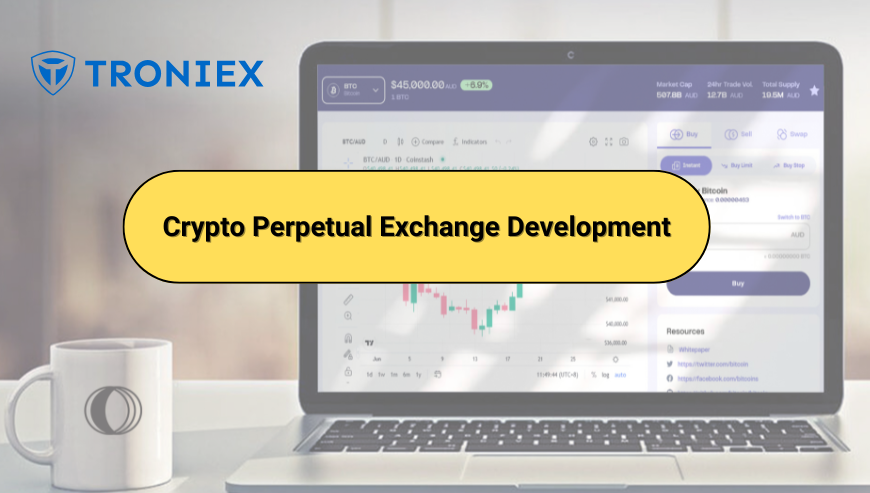As perpetual futures trading continues to gain popularity in the crypto derivatives market, businesses are increasingly looking to build their own perpetual exchange platforms. Unlike spot exchanges, perpetual exchanges require more complex architecture, advanced risk systems, and real-time market management. To help you understand what goes into creating a secure, scalable, and high-performance platform, here is a clear step-by-step process of crypto perpetual exchange development
1. Define the Platform’s Core Requirements
Every successful perpetual exchange begins with a clear vision. The first step is identifying your business goals, target traders, market scope, and technical requirements.
Key considerations:
Supported trading pairs
Leverage limits
Margin types (isolated vs. cross)
Funding rate model
Liquidity needs
Compliance requirements
These details will shape the platform’s architecture and determine the development approach.
2. Conduct Market & Technical Research
Before development starts, conducting in-depth research ensures the platform aligns with user demands and industry standards.
This stage includes:
Competitor analysis
Identifying unique features
Understanding trader behavior
Choosing blockchain infrastructure
Evaluating security protocols
Research helps in building a platform that stands out and meets global trading expectations.
3. Design the System Architecture
A perpetual exchange requires a modular and scalable architecture that can handle high transaction volumes with minimal latency.
The architecture typically includes:
Matching engine
Risk management system
Funding rate engine
Wallet infrastructure
Liquidity layer
Admin panel & compliance tools
A strong architecture ensures stability, reliability, and long-term scalability.
4. Develop the Matching Engine
The matching engine is the heart of a perpetual futures platform. It must manage orders at lightning-fast speeds and deliver precise execution.
Development focuses on:
Ultra-low latency performance
Support for multiple order types
Real-time order book synchronization
High throughput under heavy traffic
A powerful matching engine enhances trader trust and platform competitiveness.
5. Build the Risk Management Module
Leveraged trading introduces substantial risk, making a dedicated risk engine essential.
Core risk features include:
Automatic liquidation system
Insurance fund management
Cross & isolated margin calculations
Mark price and index price oracles
Auto-deleveraging (ADL) mechanisms
These systems protect traders and ensure the exchange remains solvent during volatile conditions.
6. Implement a Dynamic Funding Rate System
A defining feature of perpetual contracts is the funding rate, which keeps contract prices close to the spot market.
The system should support:
Real-time premium calculations
Scheduled funding intervals
Transparent rate display
Asset-specific funding logic
This mechanism maintains market fairness and efficient price alignment.
7. Build Strong Security Infrastructure
Perpetual exchanges handle high-value trades, so security must be multi-layered and enterprise-grade.
Essential security components:
Multi-signature cold wallets
Secure hot wallets for active liquidity
Two-factor authentication (2FA)
Anti-DDoS protection
Encrypted APIs and user data
Fraud detection algorithms
Strong security builds user trust and protects platform integrity.
8. Create an Intuitive Trading Interface
User experience plays a major role in trader retention. The interface must be fast, responsive, and informative.
Must-have features:
TradingView chart integration
Position and margin dashboards
Order book visualization
Real-time alerts
Mobile-responsive design
A clean UI improves trading efficiency and platform engagement.
9. Integrate Liquidity Solutions
Liquidity determines how smoothly traders can open and close positions.
Liquidity can be added through:
Third-party liquidity providers
Market-making bots
On-chain/off-chain aggregation
Incentivized liquidity programs
High liquidity attracts professional traders and strengthens platform credibility.
10. Build the Admin & Compliance System
A robust backend ensures smooth platform operations and regulatory compliance.
This layer includes:
User and KYC/AML management
Transaction monitoring
Fee and funding configuration
System logs and analytics
Role-based access controls
Strong admin tools are essential for long-term sustainability.
11. Test, Audit & Optimize the Platform
Before launch, the platform must undergo extensive testing.
Testing includes:
Performance and load testing
Security auditing
UI/UX testing
Smart contract and API validation
Thorough testing ensures stability and minimizes post-launch issues.
12. Deployment & Ongoing Maintenance
Finally, the exchange is deployed to a secure production environment, followed by continuous updates, monitoring, and improvements.
Post-launch improvements include:
Feature upgrades
Security patching
Liquidity enhancements
Performance optimization
Ongoing maintenance ensures the platform stays competitive and secure.
Final Thoughts
Developing a secure and profitable perpetual futures exchange involves multiple layers of planning, design, development, security enhancement, and testing. By following this structured, step-by-step process, businesses can create a high-performance platform capable of handling leveraged trading efficiently while maintaining trust, security, and long-term scalability.





Comments